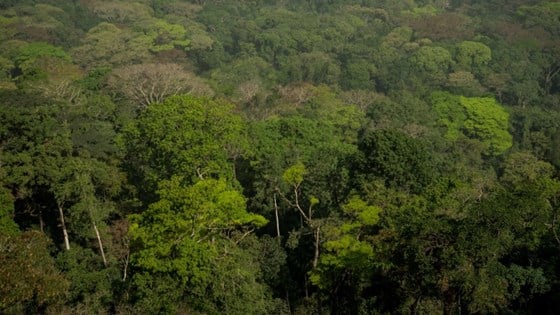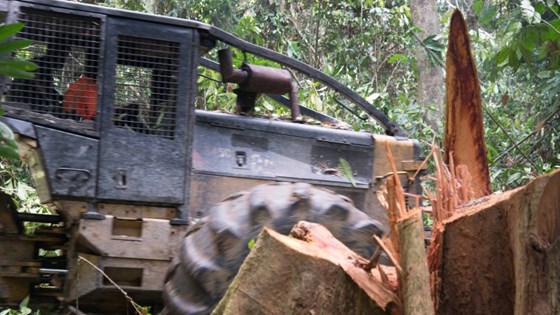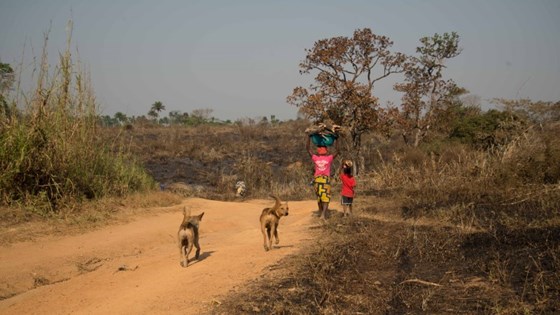Liberia
Historical archive
Published under: Solberg's Government
Publisher: Ministry of Climate and Environment
Article | Last updated: 16/02/2017
In September 2014, Liberia and Norway entered into a partnership to conserve Liberia's unique and biodiversity-rich forest and reduce greenhouse gas emissions from deforestation.

The partnership aims at facilitating green growth through emphasize on community forests, sustainable forest management and the development of a "deforestation free" agricultural sector. Norway will support Liberia’s efforts with up to NOK 1 billion until 2020.
Liberia holds 43 per cent of the remaining Upper Guinea forests of West Africa. The forests’ biological diversity encompasses the last long-term viable populations of several endemic species including the Western Chimpanzees, forest elephants and leopards. Also the rare zebra duiker and pygmy hippopotamus, in addition to over 2000 flowering plants, are to be found in the Liberian rainforest. The country is listed as one of 34 global biodiversity hotspots. This unique and distinct forest needs to be manged responsibly for the benefit of the local population, for the Liberian economy and for the global climate and biodiversity.
Powerty alleviation
Since the end of the civil war (2003) and the first democratic elections (2005), Liberia has experienced relative peace and stability. Until the onset of the Ebola Virus Disease with its devastating impact on people, public services and the economy, Liberia also experienced a period of sustained economic growth. The country is however still one of the poorest in world, and poverty alleviation and welfare development is the top priority. The combination of economic development and strong population growth is however already starting to stretch the capacity of the traditional technology of shifting cultivation and put the Liberian forest under pressure from various economic activities. The main drivers of deforestation includes expanding traditional agriculture, conversion to industrial agriculture plantations, chainsaw logging and plank production for the domestic marked, commercial logging and charcoal production. Despite political commitments and improved laws and regulations, limited capacity for effective forest and land use management exacerbates the impact of the multiple drivers.

Projects
Through the forest partnership agreement between Liberia and Norway, a series of interrelated projects is being developed to address key drivers of deforestation and stimulate green economic growth:
- A project to 1) improve forest management including monitoring of changes in forest cover 2) strengthening the capacity of rural communities to have their customary held forests areas formally recognized, and support sustainable economic activities in these forest 3) expand and improve the management of Liberia's protected area network.
These activities will improve management and enhance sustainable economic activities in priority forest landscapes, delivering multiple benefits such as resilient livelihoods, income generating activities, and emissions reductions. The 5-year project, with a USD 37 mill budget, will be implemented by the forest authorities of Liberia (FDA) with support from the World Bank. The project is accompanied by substantial technical support provided by the World Bank. Together with the related administrative costs of project management, the technical assistance is budget at about USD 6.5 mill. As such the project is subject to World Bank safeguard standards and finical management procedures. Access the full project document here.
- A partnership between the Government of Liberia, palm oil companies, local communities and civil society, to develop "deforestation free" palm oil. In this innovative model, public funds will support project development and leverage private investments for community outgrowers, in return for multi-party commitment to protect natural forest. The project is implemented by IDH (the sustainable trade initiative) in cooperation with the Government of Liberia. Access the project document for phase I here.
This project will be accompanied by efforts to establish a public-private coalition with multinational companies committed to ambitious zero deforestation policies, only allowing companies adhering to such policies – and signing up to the Tropical Forest Alliance principles – to do business in Liberia.
- Liberia has the 7th lowest per capita income in the world. Both people and economy is marked the prolonged civil war and the recent Ebola Virus Disease. The recent commitment to "clean up" the forest sector for long term sustainable management has lead to a substantial drop in short term revenue from the forest sector. To support Liberia in coping with these challenges and at the same time absorb the additional requiring costs that comes with the investment projects outlined above, Norway will also provide a general budget support to Liberia at around USD 5 mill per year over three years. The budget support follows the requirements and procedure of a parallel World Bank budget support operation. Access the agreement here.
Growing population
More than half the Liberian labour force is engaged in shifting agriculture. This has been a sustainable way of life for generations. In some parts of Liberia, a fast growing population is now pushing this traditional technology beyond the carrying capacity of the forest landscape. In Lofa county in the North-Western corner of Liberia, this has led to substantial deforestation, exacerbated by the intrusion of savannah grassland from the north. The savannah intrusion inhibits traditional agricultural practices and puts the local population under threat from wildfires and heavy winds.

In the spring of 2016, a consortium of consultants visited the area to do a needs and opportunity assessment. Their report is available here. The findings and framing for a potential Production-Protection-Inclusion landscape program is summarized in this presentation.
Implementation
The above projects and activities will support Liberia's transition to sustainable resource management and inclusive benefit sharing of forest resources. Over time, and with effective landscape management, this will put Liberia in a position to reduce deforestation rates and receive result-based payments for verified emission reductions.
Implementation of projects and program under the partnership will be flexible and adapted to the challenging socioeconomic context of Liberia.